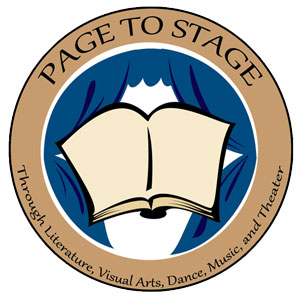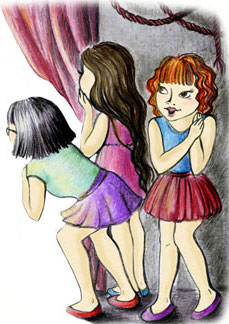|
|
Page to Stage
 Page to Stage is an instructional method that uses the four art forms: visual art, dance/creative movement, music, and theater to animate the plot and characters of a book in an interactive performance. The goal of this instructional approach is to enhance the literary experience of students by fostering their imagination through the senses. In turn, this experience offers teachers the opportunity to practice integrating the arts with literature and to design an interactive performance. The presentations also demonstrate that integration is a rich and meaningful approach to teaching and a pedagogical tool that can be utilized in all subject areas by addressing concepts, themes, subject matter, and issues. Page to Stage is an instructional method that uses the four art forms: visual art, dance/creative movement, music, and theater to animate the plot and characters of a book in an interactive performance. The goal of this instructional approach is to enhance the literary experience of students by fostering their imagination through the senses. In turn, this experience offers teachers the opportunity to practice integrating the arts with literature and to design an interactive performance. The presentations also demonstrate that integration is a rich and meaningful approach to teaching and a pedagogical tool that can be utilized in all subject areas by addressing concepts, themes, subject matter, and issues.
Visual Art Preparing the sets, costumes, and props provides students with the opportunity to use visual arts to enhance the play. An easy, yet effective way to make sets is to take large sheets of cardboard, draw pictures of objects that represent the plot, and then paint them. For example, if the setting is the West, a cactus could represent the area. Props are another inexpensive item that can enhance your play. Cloth can be used to create water or grass blowing in the wind or can be used as a backdrop for the scene. Pictures from books can also be uploaded and projected onto a screen behind the actors. Simple masks can be constructed to create the characters.
Dance/Creative Movement Various movements can be done at the beginning or end of the play or can be done as a motivational introduction. For example, if the book plot centers on the ocean, students could practice moving like sea creatures, i.e. starfish, shrimp, crabs or eels. Or, if the book setting is the West, children could learn square dances that could be completed following the play. Ribbon dancing is another movement that can be used to create the effect of water flowing or the wind blowing. The audience can also be cued to move their hands to simulate the water whenever the hear the word sea.
Music
During the interactive performance, students can sing 2-3 line verses from songs that fit the plot. The verse can be repeated throughout the play. Or, students can sing the entire song prior to or at the conclusion of the play. Select a song that correlates to the theme, mood, or overall atmosphere that is suggested by the story line. Therefore, students might sing the Tofu Ling Sets Sail Song if the plot of the book focuses on the sea. Simple instruments can be constructed to provide sound effects for the story, such as rice in a container swishing back and forth to create the sound for water. Or, the story Tofu Ling and the Carp Banner takes place during Children's Festival in Japan and the children could sing the Koinobori Song, which is the traditional song that is sung during the festival in Japan.

Theater After students are familiar with the story, they can identify the specific scenes in the story that can be performed. Then, they can show how to express the mood, emotions, and actions of the characters in the play. Practicing pantomime will help the students to show expressions that can be performed. Having someone read the story as they act it out will help the students who may have trouble remembering lines. An interactive performance provides an opportunity for the actors to engage the audience in the performance. The audience can be cued to make sounds that coordinate with the story.
Selecting a Book to Integrate and Perform The criteria to select a literature book is similar to that of any book that you would use in the classroom. Books used for integration should have an active story line with plots that are not too complicated, but yet that engage the reader. The illustrations should be vibrant and colorful, while the characters should be multi-dimensional and entertaining. The stories should include positive conflict resolutions and demonstrate the kinds of behaviors that you hope to teach your students.
Contact Us
|


 Page to Stage is an instructional method that uses the four art forms: visual art, dance/creative movement, music, and theater to animate the plot and characters of a book in an interactive performance. The goal of this instructional approach is to enhance the literary experience of students by fostering their imagination through the senses. In turn, this experience offers teachers the opportunity to practice integrating the arts with literature and to design an interactive performance. The presentations also demonstrate that integration is a rich and meaningful approach to teaching and a pedagogical tool that can be utilized in all subject areas by addressing concepts, themes, subject matter, and issues.
Page to Stage is an instructional method that uses the four art forms: visual art, dance/creative movement, music, and theater to animate the plot and characters of a book in an interactive performance. The goal of this instructional approach is to enhance the literary experience of students by fostering their imagination through the senses. In turn, this experience offers teachers the opportunity to practice integrating the arts with literature and to design an interactive performance. The presentations also demonstrate that integration is a rich and meaningful approach to teaching and a pedagogical tool that can be utilized in all subject areas by addressing concepts, themes, subject matter, and issues.
